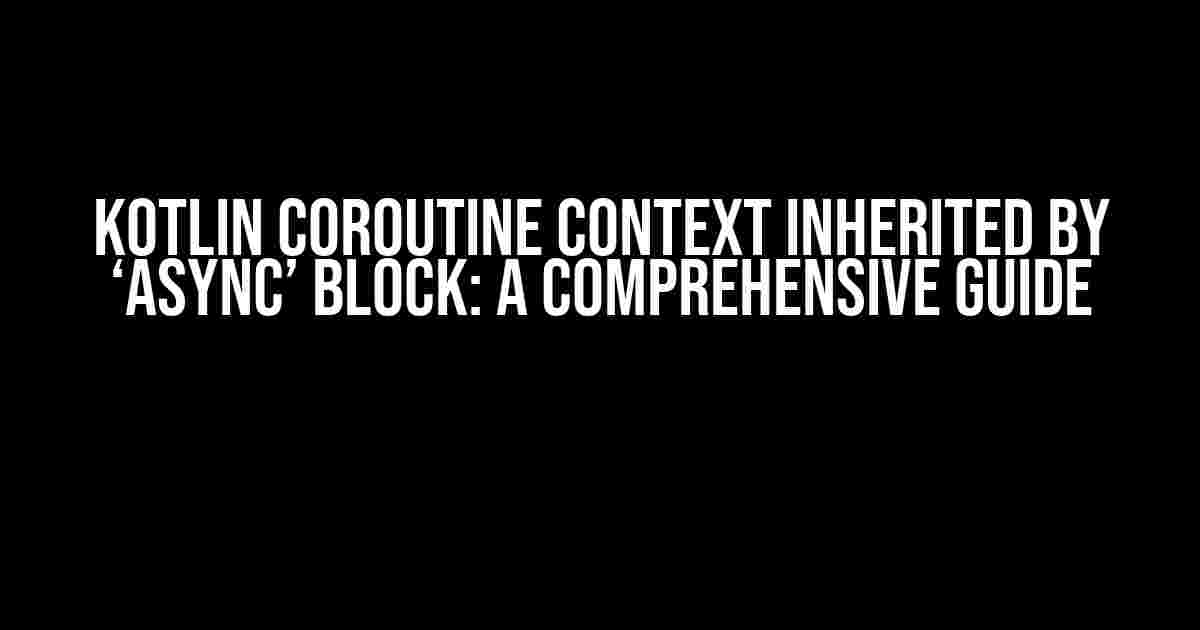Kotlin coroutines have revolutionized the way we write asynchronous code in Android and other JVM-based languages. One of the most powerful features of Kotlin coroutines is the concept of coroutine context, which allows us to manage and control the execution of coroutines. In this article, we’ll dive deep into the world of coroutine context and explore how it’s inherited by the ‘async’ block. Buckle up, folks!
What is Coroutine Context?
Coroutine context is an object that provides essential information about a coroutine, such as its job, dispatcher, and coroutine scope. It’s an instance of the CoroutineContext interface, which is a part of the kotlinx.coroutines library. The coroutine context is responsible for managing the lifecycle of a coroutine, including its creation, execution, and cancellation.
interface CoroutineContext {
val.job: Job
val.coroutineScope: CoroutineScope
val.dispatcher: ContinuationInterceptor
// ...
}
The ‘async’ Block and Coroutine Context
The ‘async’ block is a fundamental building block of Kotlin coroutines. It’s used to define a coroutine that runs asynchronously and returns a result. When you create an ‘async’ block, it inherits the coroutine context from its surrounding scope.
import kotlinx.coroutines.*
fun main() {
val scope = CoroutineScope(Dispatchers.Default)
scope.launch {
val result = async {
// This async block inherits the coroutine context from the surrounding scope
delay(1000)
"Hello, World!"
}
println(result.await())
}
}
In the example above, the ‘async’ block inherits the coroutine context from the surrounding scope, which is defined by the CoroutineScope instance. The coroutine context includes the dispatcher, which is set to Dispatchers.Default. This means that the ‘async’ block will run on the default dispatcher, which is suitable for most use cases.
How Coroutine Context is Inherited by ‘async’ Block
When you create an ‘async’ block, it captures the current coroutine context and uses it to run the asynchronous operation. This process is called context capture. The context capture mechanism ensures that the ‘async’ block has access to the necessary information, such as the job and dispatcher, to manage its execution.
| Context Element | Description |
|---|---|
| Job | The job represents the lifecycle of a coroutine. It’s responsible for managing the coroutine’s execution, cancellation, and completion. |
| Dispatcher | The dispatcher determines the thread or threads on which the coroutine will run. It’s responsible for scheduling the coroutine’s execution. |
| CoroutineScope | The coroutine scope provides a way to manage the lifetime of a coroutine. It’s responsible for canceling the coroutine when its scope is cancelled. |
Customizing Coroutine Context for ‘async’ Block
Sometimes, you might want to customize the coroutine context for a specific ‘async’ block. This can be achieved by using the withContext function, which allows you to specify a custom dispatcher for the ‘async’ block.
import kotlinx.coroutines.*
fun main() {
val scope = CoroutineScope(Dispatchers.Default)
scope.launch {
val result = withContext(Dispatchers.IO) {
async {
// This async block inherits the custom coroutine context with Dispatchers.IO
delay(1000)
"Hello, World!"
}
}
println(result.await())
}
}
In the example above, we used the withContext function to specify a custom dispatcher (Dispatchers.IO) for the ‘async’ block. This ensures that the ‘async’ block runs on the IO dispatcher, which is suitable for network I/O operations.
Best Practices for Managing Coroutine Context
When working with Kotlin coroutines, it’s essential to manage the coroutine context effectively to avoid common pitfalls and errors. Here are some best practices to keep in mind:
-
Use a coroutine scope to manage the lifetime of coroutines. This ensures that coroutines are cancelled when their scope is cancelled.
-
Avoid using global scope for coroutines. Instead, use a scoped coroutine context to manage coroutines within a specific scope.
-
Specify a custom dispatcher for coroutines that require specific thread or thread pool configuration.
-
Use the
withContextfunction to customize the coroutine context for specific ‘async’ blocks. -
Avoid capturing the coroutine context unnecessarily, as this can lead to memory leaks and performance issues.
Conclusion
In this article, we explored the concept of coroutine context and how it’s inherited by the ‘async’ block in Kotlin. We also discussed best practices for managing coroutine context to avoid common pitfalls and errors. By following these guidelines, you can write efficient and effective asynchronous code using Kotlin coroutines.
Remember, coroutine context is a powerful tool that allows you to manage and control the execution of coroutines. By understanding how it’s inherited by the ‘async’ block, you can write more robust and scalable code that takes advantage of the concurrency features provided by Kotlin coroutines.
Happy coding, and don’t forget to optimize your code for Kotlin coroutine context inherited by ‘async’ block!
Frequently Asked Question
Kotlin.coroutines.context.inherited.by.’async’.block : All Your Questions Answered!
What is the coroutine context inherited by an ‘async’ block?
The coroutine context inherited by an ‘async’ block is the context of the outer coroutine scope. This means that the ‘async’ block will inherit the dispatchers, job, and other properties from the outer coroutine scope. This is useful for creating a hierarchy of coroutines that can share resources and cancellation.
Why does the ‘async’ block inherit the coroutine context of the outer scope?
The ‘async’ block inherits the coroutine context of the outer scope because it allows for a more structured and organized concurrency model. This way, the inner coroutine can leverage the resources and configuration of the outer scope, making it easier to manage complex concurrency hierarchies.
Can I override the inherited coroutine context in an ‘async’ block?
Yes, you can override the inherited coroutine context in an ‘async’ block by providing a custom context using the ‘withContext’ function or by creating a new coroutine scope with a custom context. This allows you to customize the behavior of the inner coroutine and provide a different context if needed.
What happens if I don’t provide a coroutine context in an ‘async’ block?
If you don’t provide a coroutine context in an ‘async’ block, it will default to the context of the outer scope. If there is no outer scope, it will default to the GlobalScope. This means that the ‘async’ block will run in the global scope, which is not recommended as it can lead to resource leaks and uncontrolled concurrency.
How can I access the coroutine context of an ‘async’ block?
You can access the coroutine context of an ‘async’ block using the ‘coroutineContext’ property. This property returns a CoroutineContext object that contains information about the coroutine, such as the dispatcher, job, and other properties. You can use this object to customize the behavior of the coroutine or to access its properties.



